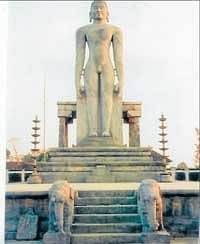
The presence of 35-foot tall monolith of Bhagawan Bahubali or Lord Gomateshwara (one of the prominent 4 in Karnataka and 2nd oldest) and many basadis make the place a popular pilgrimage centre for Jains even to this day.
Interestingly, not many people know that Karnataka has many important Jain pilgrim centres, temples and monuments. Shravanabelagola, Dharmasthala, Karkala, Moodbidri, Venur, Humcha, Narasimharajapura will astonish the visitors by their vast and abundant Jain heritage. Jainism with their rich cultural heritage and noble preaching of non-violence and peace always enjoyed a significant status in Karnataka.
With the Mahamastakabhisheka (anointing of the statue with water, tender coconut, milk, sugarcane juice and saffron paste and sprinkled with sandal wood powder, turmeric, and vermilion) scheduled to be held between January 28 and February 5, 2012 under the aegis of Dharmasthala Dharmadhikari Dr D Veerendra Heggade, the little town is gearing up to witness the anointing of the Lord. Though the Mahamastakabhisheka is performed once in 12 years, as per the records available, the ritual has been performed only three-times in Venur in the last 110-years, that is, in 1928, 1956 and the last one in 2000.
407-year-old statue
The architectural grandeur of Lord Bahubali at Venur, once the capital of the Ajila Dynasty, was established by Thimmanna Ajila (1558-1616 AD), one of the most prominent Kings of the dynasty, in 1604 AD. He was said to be a direct descendant of Chamundaraya, who built the statue at Shravanabelagola. The statue is supposed to have been sculptured by Amarashilpi Jakanachari. The Kings of Ajila Dynasty ruled the region from 1154 to 1786 AD.
The colossal idol of Lord Bahubali stands on a high platform facing westward. The beautifully carved sculpture of Lord Bahubali with elongated ears, palms stretching up to knees, curly hair, depiction of anthill and creepers entwining both hands is awesome.
As you enter this holy place, you will come across Manstambha or the column of dignity with idols of 24 Thirthankars. According to the inscriptions in the temple at Venur, this was completed in the year 1489. The shrine of Chandranatha and Shantinatha Swamy, built in stone is another gem of Venur. The statue of Lord Shantinath is built on a black rock measuring up to 5 feet in height and is a magnificent piece of art. This apart, there are Jain basadis scattered throughout the little town, that include Sri Adeeshwara swamy basadi, Sri Parshwanatha swamy basadi and Sri Shanthishwara swamy basadi.
Artistic works, great sceneries and beautiful architecture make Venur a great place to visit. Besides the richness of religion, Venur also provides a lot of insight to the Jain history and its evolution.
With the State government releasing Rs 2 crore to develop infrastructure in the region and with an expected 2 lakh visitors to the little town, the 2nd Mahamastakabhisheka in this century is going to be a mega event.
Speaking to City Herald, Padmaprasad Ajila, the descendent (14th generation) of Thimmanna Ajila, said that the Jains have also planned novel projects including organising medical camps in and around Venur for the benefit of all people irrespective or caste or creed. Meanwhile, former minister and MLA Abhayachandra Jain, who also hails from the same community, said that the poojas on each day (for 9 days) would cost approximate Rs 8 lakh, besides other expenses.
Interestingly, there is a strong belief that Mahamastakabhisheka would also cleanse the human beings after witnessing the glorious ceremony for the lord, who personified sacrifice, non-violence and compassion. Each ingredient poured on the Lord has its own significance — water to cleanse, sandalwood to spread the fragrance of Lord’s virtues, milk as a symbol of purity, cane juice to relieve hunger and choorna to beautify!
Legend
According to Jain scriptures, Bahubali was the second of the 100 sons of the first Thirthankara, Lord Rishabha and was the king of Podanpur. He was known for the strength in his arms as depicted by his name.
Legend has it that Bahubali was challenged by his brother Bharatha over the succession to the throne. Bahubali took on the challenge and duelled with his brother in three forms such as ‘Drishtiyuddha,’ ‘Mallayuddha’ and ‘Jalayuddha’.
Bahubali emerged victorious but was disgusted with the quest of material wealth that made him fight his own brother. Renouncing his kingdom and all worldly pleasures, he went on to pursue ‘Moksha’ (salvation) and stood in a deep meditation for years.
How to reach
Venur is situated about 55 km away from Mangalore, between Moodbidre and Guruvayanakere. There are many buses to Venur from Moodbidre as well as Guruvayanakere (Belthangady). Its walkable distance from Venur to the monolith statue, which is hardly 400 metres away.
Shortest among 4
The 35-foot statue of Bhagawan Bahubali in Venur is the shortest among four statues while the 57-foot statue at Shravanabelagola is the tallest. The statues at Karkala and Dharmasthala are 42-foot and 39-foot tall respectively.
The architectural grandeur of Lord Bahubali at Shravanabelagola is considered to be the world’s largest monolithic stone statue (and also the oldest) with inscriptions in Kannada and Tamil dating back to 981 AD. The statue at Venur, the 2nd oldest statue, dates back to 1604. The statues at Karkala and Dharmasthala were established in 1432 and 1975 respectively.
As per the tradition, the next Mahamastakabhisheka at Karkala, Shravanabelagola and Dharmasthala will be held in 2014, 2018 and 2019 respectively.